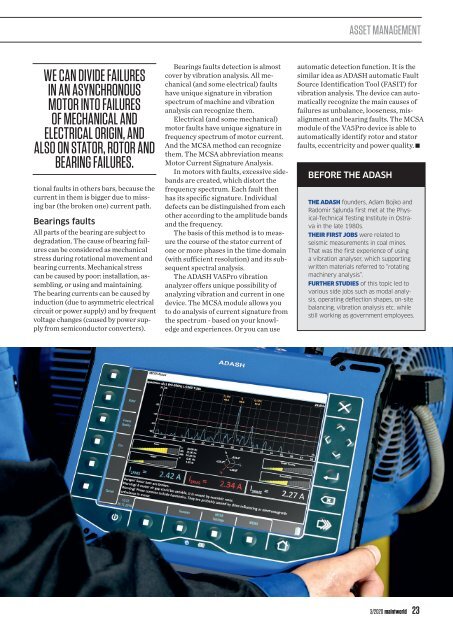Maintworld 3/2020
Maintworld magazine - maintenance & asset management Maintenance and reliability in the pandemic PEOPLE, THE MOST VALUABLE ASSET IN YOUR ORGANIZATION UNITED NATIONS OF AUTOMATION ČSPÚ 20 YEARS OF CZECH INDUSTRIAL MAINTENANCE
Maintworld magazine - maintenance & asset management
Maintenance and reliability in the pandemic
PEOPLE, THE MOST VALUABLE ASSET IN YOUR ORGANIZATION
UNITED NATIONS OF AUTOMATION
ČSPÚ 20 YEARS OF CZECH INDUSTRIAL MAINTENANCE
You also want an ePaper? Increase the reach of your titles
YUMPU automatically turns print PDFs into web optimized ePapers that Google loves.
ASSET MANAGEMENT<br />
WE CAN DIVIDE FAILURES<br />
IN AN ASYNCHRONOUS<br />
MOTOR INTO FAILURES<br />
OF MECHANICAL AND<br />
ELECTRICAL ORIGIN, AND<br />
ALSO ON STATOR, ROTOR AND<br />
BEARING FAILURES.<br />
tional faults in others bars, because the<br />
current in them is bigger due to missing<br />
bar (the broken one) current path.<br />
Bearings faults<br />
All parts of the bearing are subject to<br />
degradation. The cause of bearing failures<br />
can be considered as mechanical<br />
stress during rotational movement and<br />
bearing currents. Mechanical stress<br />
can be caused by poor: installation, assembling,<br />
or using and maintaining.<br />
The bearing currents can be caused by<br />
induction (due to asymmetric electrical<br />
circuit or power supply) and by frequent<br />
voltage changes (caused by power supply<br />
from semiconductor converters).<br />
Bearings faults detection is almost<br />
cover by vibration analysis. All mechanical<br />
(and some electrical) faults<br />
have unique signature in vibration<br />
spectrum of machine and vibration<br />
analysis can recognize them.<br />
Electrical (and some mechanical)<br />
motor faults have unique signature in<br />
frequency spectrum of motor current.<br />
And the MCSA method can recognize<br />
them. The MCSA abbreviation means:<br />
Motor Current Signature Analysis.<br />
In motors with faults, excessive sidebands<br />
are created, which distort the<br />
frequency spectrum. Each fault then<br />
has its specific signature. Individual<br />
defects can be distinguished from each<br />
other according to the amplitude bands<br />
and the frequency.<br />
The basis of this method is to measure<br />
the course of the stator current of<br />
one or more phases in the time domain<br />
(with sufficient resolution) and its subsequent<br />
spectral analysis.<br />
The ADASH VA5Pro vibration<br />
analyzer offers unique possibility of<br />
analyzing vibration and current in one<br />
device. The MCSA module allows you<br />
to do analysis of current signature from<br />
the spectrum - based on your knowledge<br />
and experiences. Or you can use<br />
automatic detection function. It is the<br />
similar idea as ADASH automatic Fault<br />
Source Identification Tool (FASIT) for<br />
vibration analysis. The device can automatically<br />
recognize the main causes of<br />
failures as unbalance, looseness, misalignment<br />
and bearing faults. The MCSA<br />
module of the VA5Pro device is able to<br />
automatically identify rotor and stator<br />
faults, eccentricity and power quality.<br />
BEFORE THE ADASH<br />
THE ADASH founders, Adam Bojko and<br />
Radomir Sglunda first met at the Physical-Technical<br />
Testing Institute in Ostrava<br />
in the late 1980s.<br />
THEIR FIRST JOBS were related to<br />
seismic measurements in coal mines.<br />
That was the first experience of using<br />
a vibration analyser, which supporting<br />
written materials referred to “rotating<br />
machinery analysis”.<br />
FURTHER STUDIES of this topic led to<br />
various side jobs such as modal analysis,<br />
operating deflection shapes, on-site<br />
balancing, vibration analysis etc. while<br />
still working as government employees.<br />
3/<strong>2020</strong> maintworld 23

















